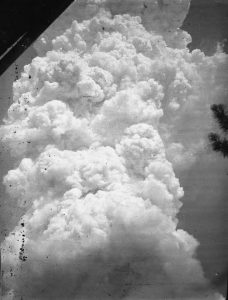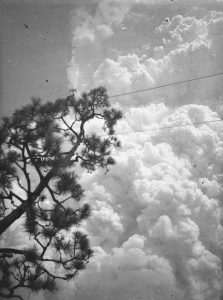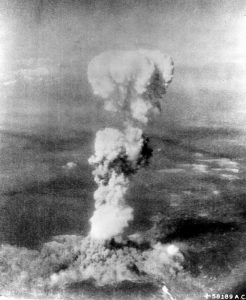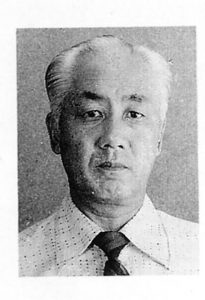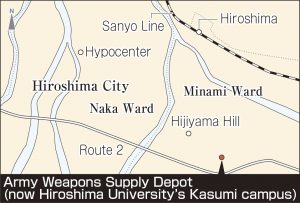Striving to fill voids in Hiroshima, evidence of victims remains 76 years after atomic bombing—Photos of A-bombing destruction, Part 2: Rising mushroom cloud captured up close by Toshio Fukada
Dec. 6, 2021
Observing smoke from bombing, “reflexively” took series of shots
Photos at Peace Memorial Museum show youth’s view
by Junji Akechi, Staff Writer
Four photographs were taken from below the huge cloud rising into the sky. With building eaves and pine branches incorporated, each shot was taken from a slightly different angle, revealing the emotions of the photographer as he tried to capture within the frame the cloud from the atomic bombing as it quickly changed shape. The photos were taken by Toshio Fukada about 2.6 kilometers southeast of the hypocenter immediately after the atomic bombing. Mr. Fukada, who was 16 at the time, died in 2009 at the age of 80.
Graduating from the former Sotoku Junior High School after four years of schooling there, Mr. Fukada was mobilized to work at the Army Weapons Supply Depot (now the Kasumi campus of Hiroshima University, located in the city’s Minami Ward). “Many of my schoolmates were keen on photography, as was I,” according to his statement in the Record of the Hiroshima A-bomb Disaster, published in 1971. On August 6, 1945, Mr. Fukada was carrying a small camera in a back pocket of his trousers, as was typical for him.
Taken from north window on second floor
The circumstances of how Mr. Fukada took the photos can be assessed from his spoken and written descriptions. After morning assembly, he was awaiting instructions in front of the red-brick armory where he was scheduled to work. He felt a flash of light and immediately ducked inside the building. Shortly after that, he was blown over by the bomb’s blast. When he managed to make his way outside through a contorted iron door, he saw “a huge plume of smoke the likes of which I had never seen before” rising into the sky.
“I reflexively reached into my pocket.” He knew he was not allowed to take photos at military facilities and asked a friend to stand watch as he continued to stand and snap the camera’s shutter from a window on the north side of the second floor. Unlike the aerial photographs of the mushroom cloud taken by the U.S. military from above after the atomic bombing, Mr. Fukada’s photos do not capture the entire cloud. “I couldn’t have imagined it was smoke from the world’s first atomic bomb.”
Many mobilized students have written about the destruction to the depot from the bombing. One such student, Motonobu Okajima, 90, a resident of Hiroshima’s Saeki Ward, was a third-year student at the former Shudo Junior High School. “Most of the wooden buildings were destroyed. And the windowpanes of the solid red-brick barracks were smashed into pieces,” he has described in writings. “Was exposed to the bombing in the armory and covered in blood due to wounds from broken glass,” he wrote. He also looked up at the cloud from the depot but wrote that, “I didn’t have the capacity to even imagine what it was.” At least 20 photos of the Hiroshima cloud from the atomic bombing taken from the ground are known to exist, but Mr. Fukada’s photos are the closest of all, hastily snapped amid the indescribable chaos.
Continued photography after war
After the war, Mr. Fukada ran a camera shop and joined a group of photographers called the Association of Photographers of the Atomic Bomb Destruction of Hiroshima, which was established in 1978. He took photos of buildings of the weapons supply depot as they were being dismantled. His sister Kazuko Fukada, 91, a resident of Hiroshima’s Naka Ward, has said, “He didn’t tell his family about the photos of the atomic bombing. I guess he didn’t want to recall the tragic images of that time.” Mr. Fukada donated the negatives he had carefully kept at home to the Peace Memorial Museum in 2004. He died in 2009.
To identify the location from which Mr. Fukada took the photos, this reporter received cooperation from Tsugifumi Fujino, professor emeritus at Hiroshima University and a specialist in archaeology who was involved in excavation surveys of the university’s Kasumi campus. By comparing descriptions of “Building No. 2” and the “Armory” with the layout drawings of the prewar depot, it became understood that the photos had been taken around the southeast part of the multi-story parking garage that is now located in the northwest part of the campus.
Now that the campus has undergone redevelopment, there is no knowing what things were like at that time. But the photos left behind by Mr. Fukada show how a teenager looked up at the huge cloud from the presumed location while still in the dark about exactly what had happened. His enlarged photos are still on display at the entrance to the main building of the Hiroshima Peace Memorial Museum.
(Originally published on December 6, 2021)

